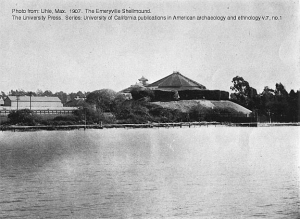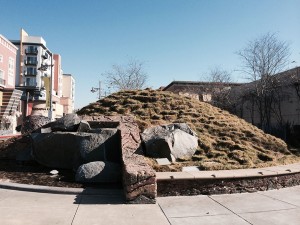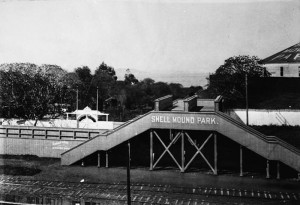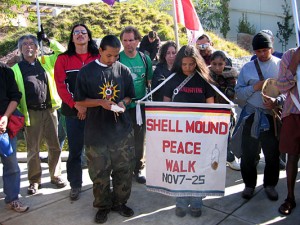Before the Spanish arrived in the 1700s, the Bay Area was home to the Ohlone people. But little evidence remains to tell their story. After all, Histories tend to bury those that come before—a brutal truth embodied by the Ohlone shellmounds. These midden deposits were sacred burial grounds crucial to establishing genealogy and territorial rights. The largest shellmound, having suffered the erosion of time and conquest, lies buried beneath Emeryville’s shopping center; the remains of Ohlone ancestors still rest beneath department stores and parking lots.
It’s too bad the monument is gone. 60 feet high and 350 feet in diameter, it would have been an impressive landmark. And a very historical one: built from 500 BC until the arrival of the Europeans, the massive structure contained over two millennia of human history—of sacred human history. In 1924, archaeologists discovered over 700 burials: “…physical remains (houses, artifacts and other materials) of past people who were probably revered as ancestors by the living.” (Lightfoot: 1997). According to this same scholar, “The repeated construction and use of the mounds forged a direct link between the living and the dead. Bay Area peoples dwelled on top of mounds whose cores encapsulated the sacred remains of their ancestors going back many generations…” And now, a modest memorial keeps their vigil behind an Old Navy.
But the site was already ravaged before the Emeryville Redevelopment Agency started building their commercial haven in 1999. From 1870 until the 1920’s it was a tourist destination (in)appropriately called “Shellmound Park”. When Prohibition hit and the amusement park failed, it became an industrial plant. At that point, it wasn’t even fully excavated: when the land underwent redevelopment in the 1990s, hundreds of human remains (aside from those found in 1924) were uncovered and either incinerated or taken to landfills. History quite literally demolishes history.
Nevertheless, there are those who still remember the bay area’s Ohlone origin. Every year around Black Friday—the day of sanctioned national consumerism—a group of protestors called the “Shellmound Walkers” march from the Intertribal Friendship House in Oakland to the shopping center in Emeryville. In remembrance of their ancestors, Morning Star Gali and her fellow Shellmound Walkers reminded shoppers that they are shopping on ruined graves.
It is easy to imagine the beauty of such a burial. With the bones of all living things collected in one great structure, this practice suggests a closer, more sympathetic connection with nature, one in which humans and animals consist of the same material. All remains, not just human, are sacred and worthy of memorial. In our age of green burial and coral reef burial, it is important to remember that such trends in burial practices—whatever their ideological underpinnings may be—have their roots in the ancient practices that were lost because of the mistakes of our past, and for which we can only begin to redeem ourselves by remembering.
More from Cultural Perspectives:
- Tolkotin Native Americans: Rituals for the End of Life and Burial
- Celtic Dreamlands and Burial Rites
- Traditional Burial Rites for the Maori

 Ohlone Shellmound Buried Beneath the Emeryville Shopping Center
Ohlone Shellmound Buried Beneath the Emeryville Shopping Center






 First the Wealth Gap, Now the U.S. Has a Growing Health Gap
First the Wealth Gap, Now the U.S. Has a Growing Health Gap
 How to Comfort A Dying Loved One
How to Comfort A Dying Loved One
 Our Annual Seven Holiday Gifts for Someone Who Is Grieving, 2024 Edition
Our Annual Seven Holiday Gifts for Someone Who Is Grieving, 2024 Edition














